Operations and Project Management Assignment
VerifiedAdded on 2021/02/19
|14
|4250
|22
AI Summary
Contribute Materials
Your contribution can guide someone’s learning journey. Share your
documents today.

Operations and Project
Management
Management
Secure Best Marks with AI Grader
Need help grading? Try our AI Grader for instant feedback on your assignments.
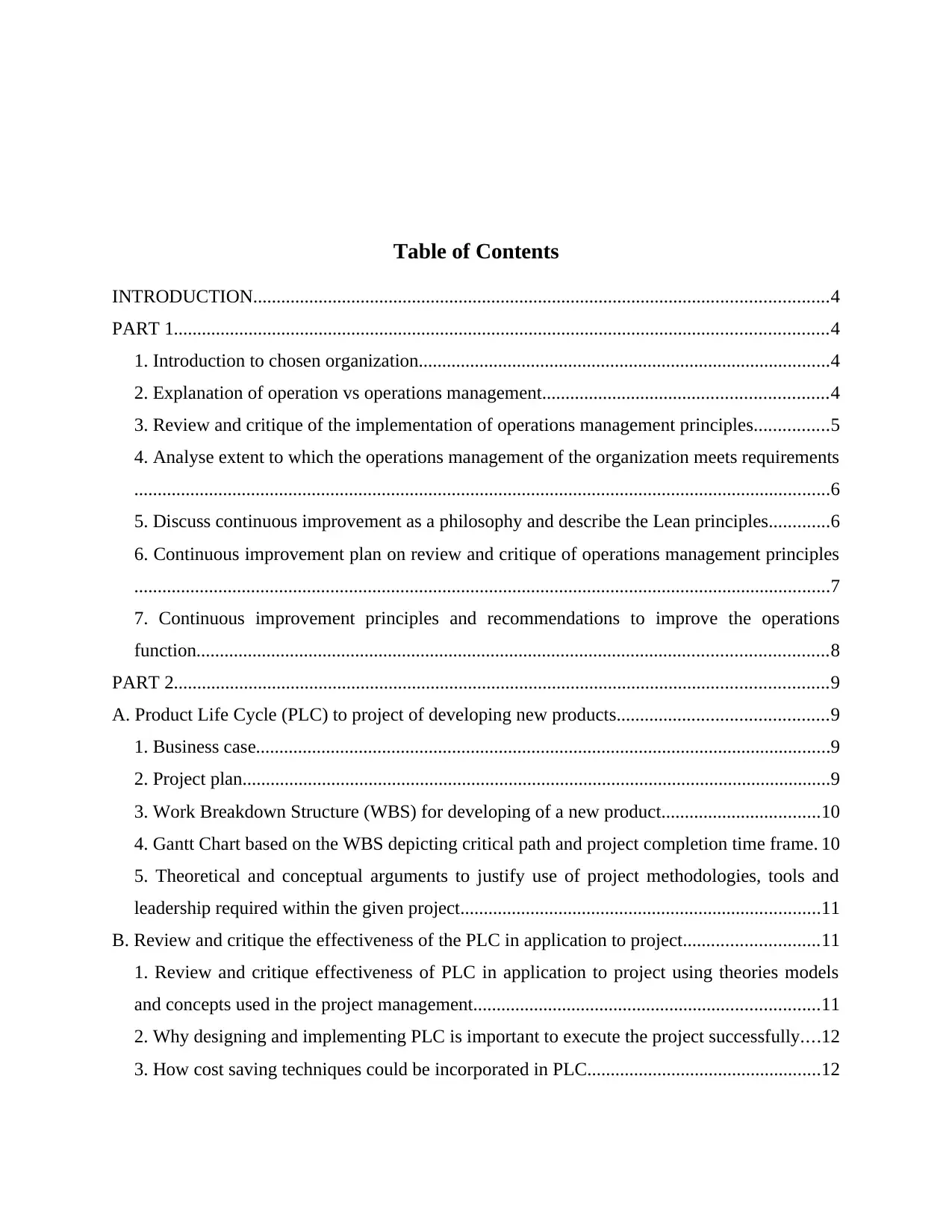
Table of Contents
INTRODUCTION...........................................................................................................................4
PART 1............................................................................................................................................4
1. Introduction to chosen organization........................................................................................4
2. Explanation of operation vs operations management.............................................................4
3. Review and critique of the implementation of operations management principles................5
4. Analyse extent to which the operations management of the organization meets requirements
.....................................................................................................................................................6
5. Discuss continuous improvement as a philosophy and describe the Lean principles.............6
6. Continuous improvement plan on review and critique of operations management principles
.....................................................................................................................................................7
7. Continuous improvement principles and recommendations to improve the operations
function.......................................................................................................................................8
PART 2............................................................................................................................................9
A. Product Life Cycle (PLC) to project of developing new products.............................................9
1. Business case...........................................................................................................................9
2. Project plan..............................................................................................................................9
3. Work Breakdown Structure (WBS) for developing of a new product..................................10
4. Gantt Chart based on the WBS depicting critical path and project completion time frame. 10
5. Theoretical and conceptual arguments to justify use of project methodologies, tools and
leadership required within the given project.............................................................................11
B. Review and critique the effectiveness of the PLC in application to project.............................11
1. Review and critique effectiveness of PLC in application to project using theories models
and concepts used in the project management..........................................................................11
2. Why designing and implementing PLC is important to execute the project successfully....12
3. How cost saving techniques could be incorporated in PLC..................................................12
INTRODUCTION...........................................................................................................................4
PART 1............................................................................................................................................4
1. Introduction to chosen organization........................................................................................4
2. Explanation of operation vs operations management.............................................................4
3. Review and critique of the implementation of operations management principles................5
4. Analyse extent to which the operations management of the organization meets requirements
.....................................................................................................................................................6
5. Discuss continuous improvement as a philosophy and describe the Lean principles.............6
6. Continuous improvement plan on review and critique of operations management principles
.....................................................................................................................................................7
7. Continuous improvement principles and recommendations to improve the operations
function.......................................................................................................................................8
PART 2............................................................................................................................................9
A. Product Life Cycle (PLC) to project of developing new products.............................................9
1. Business case...........................................................................................................................9
2. Project plan..............................................................................................................................9
3. Work Breakdown Structure (WBS) for developing of a new product..................................10
4. Gantt Chart based on the WBS depicting critical path and project completion time frame. 10
5. Theoretical and conceptual arguments to justify use of project methodologies, tools and
leadership required within the given project.............................................................................11
B. Review and critique the effectiveness of the PLC in application to project.............................11
1. Review and critique effectiveness of PLC in application to project using theories models
and concepts used in the project management..........................................................................11
2. Why designing and implementing PLC is important to execute the project successfully....12
3. How cost saving techniques could be incorporated in PLC..................................................12
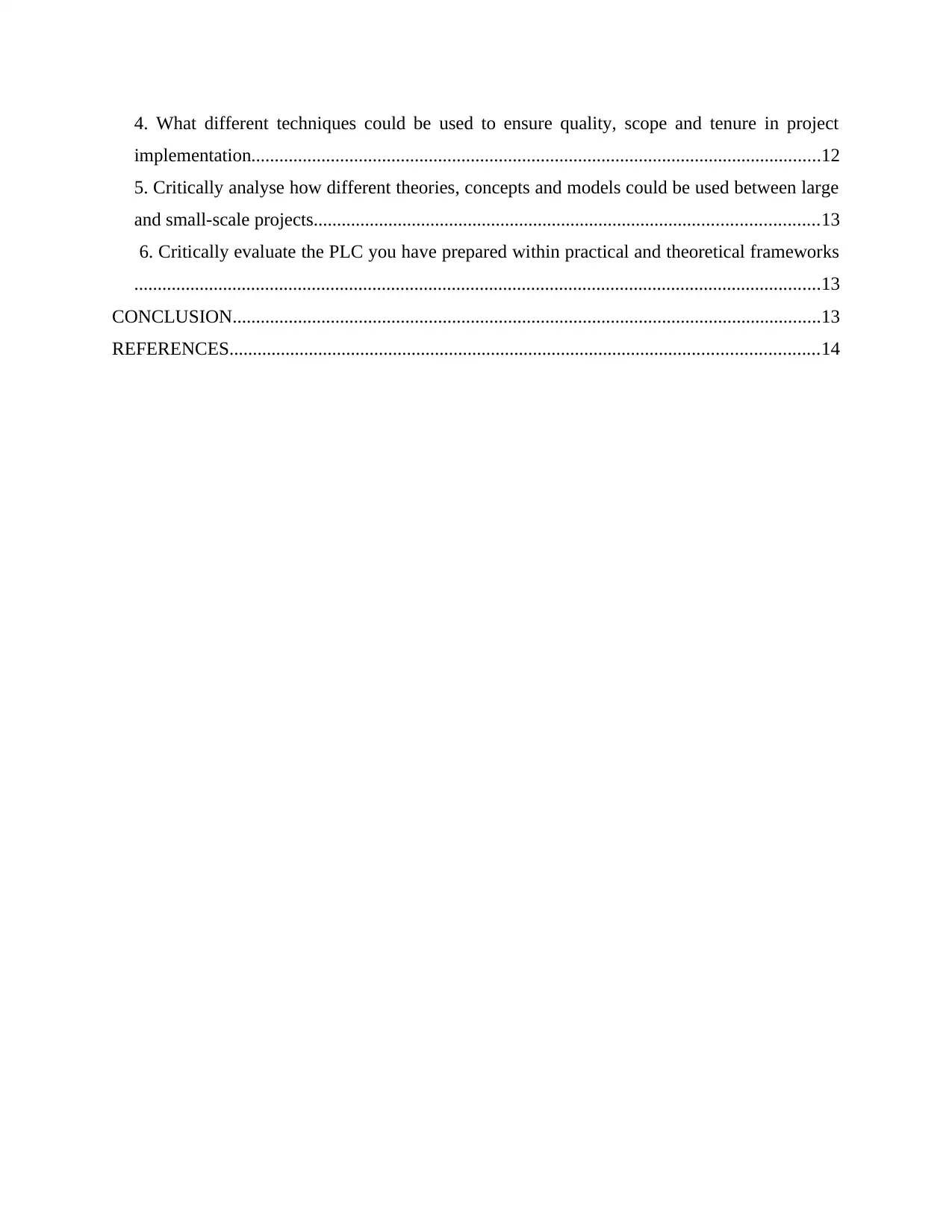
4. What different techniques could be used to ensure quality, scope and tenure in project
implementation..........................................................................................................................12
5. Critically analyse how different theories, concepts and models could be used between large
and small-scale projects............................................................................................................13
6. Critically evaluate the PLC you have prepared within practical and theoretical frameworks
...................................................................................................................................................13
CONCLUSION..............................................................................................................................13
REFERENCES..............................................................................................................................14
implementation..........................................................................................................................12
5. Critically analyse how different theories, concepts and models could be used between large
and small-scale projects............................................................................................................13
6. Critically evaluate the PLC you have prepared within practical and theoretical frameworks
...................................................................................................................................................13
CONCLUSION..............................................................................................................................13
REFERENCES..............................................................................................................................14

INTRODUCTION
Operations management is defined as responsibility for directing, overseeing and
controlling operations of business (Beringer, Jonas and Kock, 2013). This includes
manufacturing, accounting, maintenance, productions, software support. Project management is
defined as application of tools, knowledge, skills and techniques for meeting requirements of
project. These both are important function of organisation for achievement of goals and
objectives. The given report is based on two sections and two companies. The first chosen
organisation is Marks and Spencer which was founded at United Kingdom that deals in retail
sector. The second organisation is Sunshine Drinks which manufactures and sell fruit drinks. The
aim of report is to explain about operations management principles and concept of continuous
improvement. It also highlights about product life cycle and their application.
PART 1
1. Introduction to chosen organization
The chosen organisation is Marks and Spencer which was founded in 1884 at United
Kingdom. This is retail multinational firm founded by Thomas Spencer and Michael Marks. It
deals in food, clothing and home products at high quality. There are 1463 locations where it is
operating their business and providing goods and services to consumers. It is serving its goods
and services worldwide with high quality. There are various brands of Marks and Spencer such
as autograph, classic, per una and others which are serving at international market. The key
people of this organisation are Steve Rowe chief executive and Archie Norman as chairman. It
has more than 960 stores out of which 615 sells food product to consumers.
2. Explanation of operation vs operations management
Operations
Operations are defined as business activities which helps firm to convert raw materials
into finished goods and services and selling to consumer for earning profits (Gunasekaran and
Ngai, 2012). These procedures are used for creating products and services where they market
them to their consumers and delivering final goods. The business activities of organization are
different from each other. The manufacture activities mainly consist of buying materials and
converting them into actual goods and services.
Operation Management
Operations management is defined as responsibility for directing, overseeing and
controlling operations of business (Beringer, Jonas and Kock, 2013). This includes
manufacturing, accounting, maintenance, productions, software support. Project management is
defined as application of tools, knowledge, skills and techniques for meeting requirements of
project. These both are important function of organisation for achievement of goals and
objectives. The given report is based on two sections and two companies. The first chosen
organisation is Marks and Spencer which was founded at United Kingdom that deals in retail
sector. The second organisation is Sunshine Drinks which manufactures and sell fruit drinks. The
aim of report is to explain about operations management principles and concept of continuous
improvement. It also highlights about product life cycle and their application.
PART 1
1. Introduction to chosen organization
The chosen organisation is Marks and Spencer which was founded in 1884 at United
Kingdom. This is retail multinational firm founded by Thomas Spencer and Michael Marks. It
deals in food, clothing and home products at high quality. There are 1463 locations where it is
operating their business and providing goods and services to consumers. It is serving its goods
and services worldwide with high quality. There are various brands of Marks and Spencer such
as autograph, classic, per una and others which are serving at international market. The key
people of this organisation are Steve Rowe chief executive and Archie Norman as chairman. It
has more than 960 stores out of which 615 sells food product to consumers.
2. Explanation of operation vs operations management
Operations
Operations are defined as business activities which helps firm to convert raw materials
into finished goods and services and selling to consumer for earning profits (Gunasekaran and
Ngai, 2012). These procedures are used for creating products and services where they market
them to their consumers and delivering final goods. The business activities of organization are
different from each other. The manufacture activities mainly consist of buying materials and
converting them into actual goods and services.
Operation Management
Secure Best Marks with AI Grader
Need help grading? Try our AI Grader for instant feedback on your assignments.
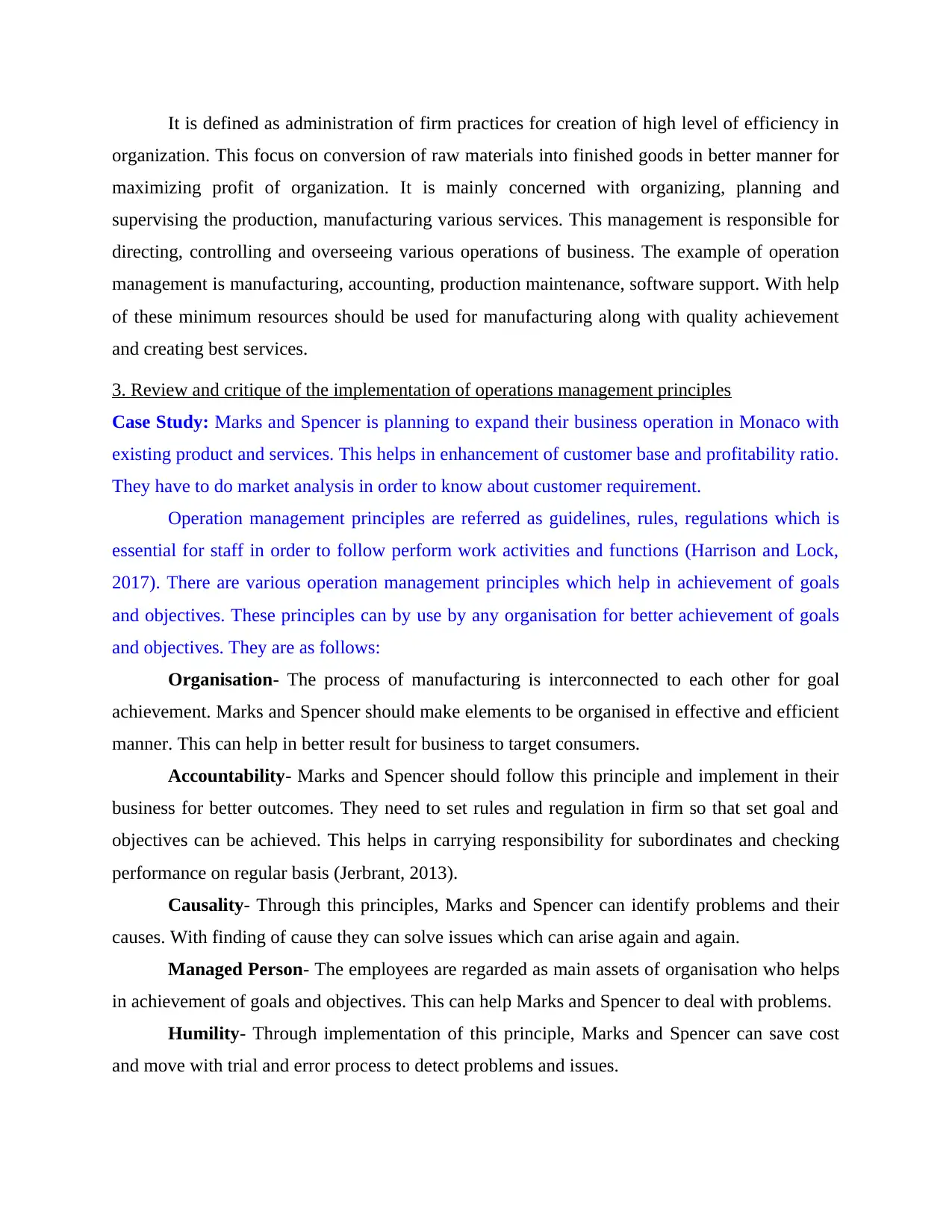
It is defined as administration of firm practices for creation of high level of efficiency in
organization. This focus on conversion of raw materials into finished goods in better manner for
maximizing profit of organization. It is mainly concerned with organizing, planning and
supervising the production, manufacturing various services. This management is responsible for
directing, controlling and overseeing various operations of business. The example of operation
management is manufacturing, accounting, production maintenance, software support. With help
of these minimum resources should be used for manufacturing along with quality achievement
and creating best services.
3. Review and critique of the implementation of operations management principles
Case Study: Marks and Spencer is planning to expand their business operation in Monaco with
existing product and services. This helps in enhancement of customer base and profitability ratio.
They have to do market analysis in order to know about customer requirement.
Operation management principles are referred as guidelines, rules, regulations which is
essential for staff in order to follow perform work activities and functions (Harrison and Lock,
2017). There are various operation management principles which help in achievement of goals
and objectives. These principles can by use by any organisation for better achievement of goals
and objectives. They are as follows:
Organisation- The process of manufacturing is interconnected to each other for goal
achievement. Marks and Spencer should make elements to be organised in effective and efficient
manner. This can help in better result for business to target consumers.
Accountability- Marks and Spencer should follow this principle and implement in their
business for better outcomes. They need to set rules and regulation in firm so that set goal and
objectives can be achieved. This helps in carrying responsibility for subordinates and checking
performance on regular basis (Jerbrant, 2013).
Causality- Through this principles, Marks and Spencer can identify problems and their
causes. With finding of cause they can solve issues which can arise again and again.
Managed Person- The employees are regarded as main assets of organisation who helps
in achievement of goals and objectives. This can help Marks and Spencer to deal with problems.
Humility- Through implementation of this principle, Marks and Spencer can save cost
and move with trial and error process to detect problems and issues.
organization. This focus on conversion of raw materials into finished goods in better manner for
maximizing profit of organization. It is mainly concerned with organizing, planning and
supervising the production, manufacturing various services. This management is responsible for
directing, controlling and overseeing various operations of business. The example of operation
management is manufacturing, accounting, production maintenance, software support. With help
of these minimum resources should be used for manufacturing along with quality achievement
and creating best services.
3. Review and critique of the implementation of operations management principles
Case Study: Marks and Spencer is planning to expand their business operation in Monaco with
existing product and services. This helps in enhancement of customer base and profitability ratio.
They have to do market analysis in order to know about customer requirement.
Operation management principles are referred as guidelines, rules, regulations which is
essential for staff in order to follow perform work activities and functions (Harrison and Lock,
2017). There are various operation management principles which help in achievement of goals
and objectives. These principles can by use by any organisation for better achievement of goals
and objectives. They are as follows:
Organisation- The process of manufacturing is interconnected to each other for goal
achievement. Marks and Spencer should make elements to be organised in effective and efficient
manner. This can help in better result for business to target consumers.
Accountability- Marks and Spencer should follow this principle and implement in their
business for better outcomes. They need to set rules and regulation in firm so that set goal and
objectives can be achieved. This helps in carrying responsibility for subordinates and checking
performance on regular basis (Jerbrant, 2013).
Causality- Through this principles, Marks and Spencer can identify problems and their
causes. With finding of cause they can solve issues which can arise again and again.
Managed Person- The employees are regarded as main assets of organisation who helps
in achievement of goals and objectives. This can help Marks and Spencer to deal with problems.
Humility- Through implementation of this principle, Marks and Spencer can save cost
and move with trial and error process to detect problems and issues.
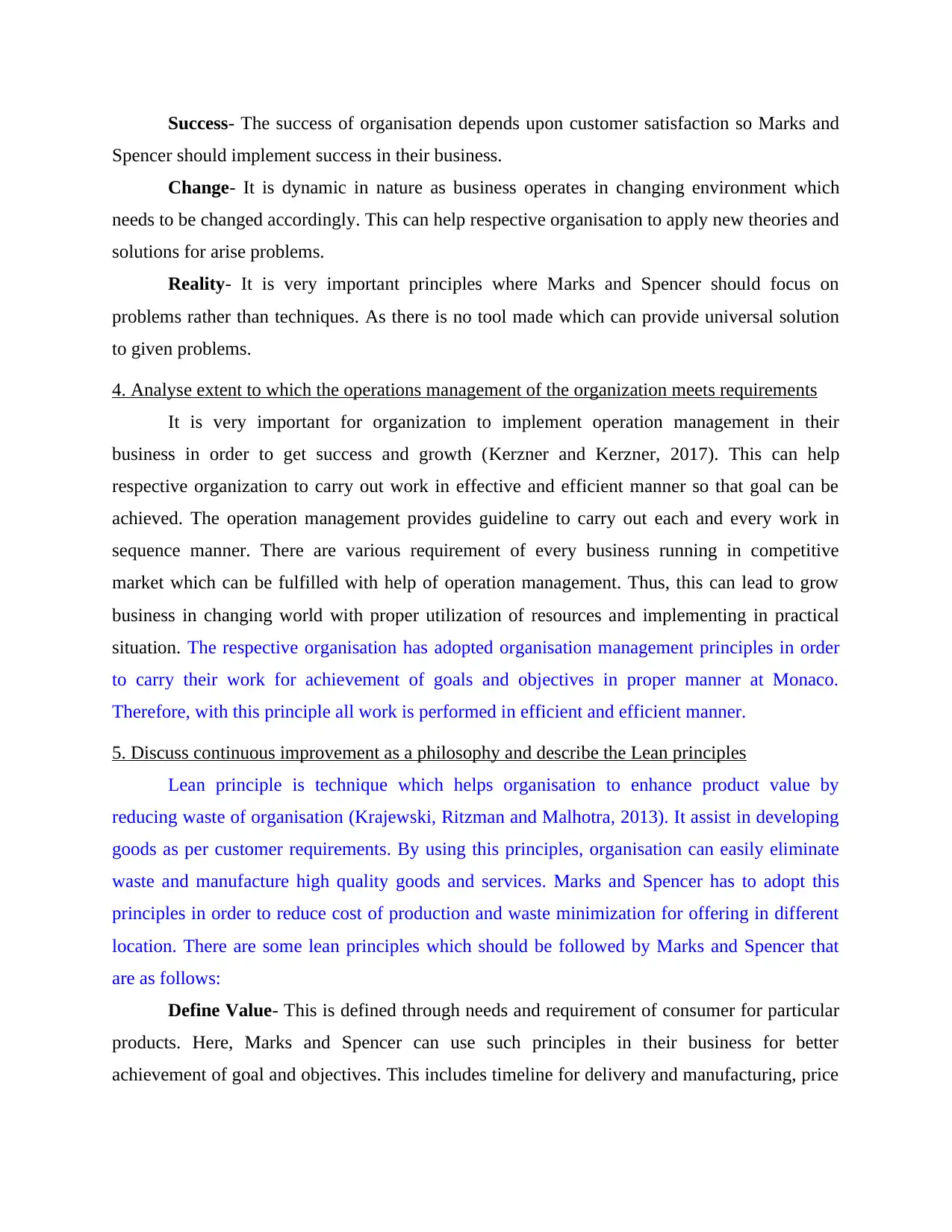
Success- The success of organisation depends upon customer satisfaction so Marks and
Spencer should implement success in their business.
Change- It is dynamic in nature as business operates in changing environment which
needs to be changed accordingly. This can help respective organisation to apply new theories and
solutions for arise problems.
Reality- It is very important principles where Marks and Spencer should focus on
problems rather than techniques. As there is no tool made which can provide universal solution
to given problems.
4. Analyse extent to which the operations management of the organization meets requirements
It is very important for organization to implement operation management in their
business in order to get success and growth (Kerzner and Kerzner, 2017). This can help
respective organization to carry out work in effective and efficient manner so that goal can be
achieved. The operation management provides guideline to carry out each and every work in
sequence manner. There are various requirement of every business running in competitive
market which can be fulfilled with help of operation management. Thus, this can lead to grow
business in changing world with proper utilization of resources and implementing in practical
situation. The respective organisation has adopted organisation management principles in order
to carry their work for achievement of goals and objectives in proper manner at Monaco.
Therefore, with this principle all work is performed in efficient and efficient manner.
5. Discuss continuous improvement as a philosophy and describe the Lean principles
Lean principle is technique which helps organisation to enhance product value by
reducing waste of organisation (Krajewski, Ritzman and Malhotra, 2013). It assist in developing
goods as per customer requirements. By using this principles, organisation can easily eliminate
waste and manufacture high quality goods and services. Marks and Spencer has to adopt this
principles in order to reduce cost of production and waste minimization for offering in different
location. There are some lean principles which should be followed by Marks and Spencer that
are as follows:
Define Value- This is defined through needs and requirement of consumer for particular
products. Here, Marks and Spencer can use such principles in their business for better
achievement of goal and objectives. This includes timeline for delivery and manufacturing, price
Spencer should implement success in their business.
Change- It is dynamic in nature as business operates in changing environment which
needs to be changed accordingly. This can help respective organisation to apply new theories and
solutions for arise problems.
Reality- It is very important principles where Marks and Spencer should focus on
problems rather than techniques. As there is no tool made which can provide universal solution
to given problems.
4. Analyse extent to which the operations management of the organization meets requirements
It is very important for organization to implement operation management in their
business in order to get success and growth (Kerzner and Kerzner, 2017). This can help
respective organization to carry out work in effective and efficient manner so that goal can be
achieved. The operation management provides guideline to carry out each and every work in
sequence manner. There are various requirement of every business running in competitive
market which can be fulfilled with help of operation management. Thus, this can lead to grow
business in changing world with proper utilization of resources and implementing in practical
situation. The respective organisation has adopted organisation management principles in order
to carry their work for achievement of goals and objectives in proper manner at Monaco.
Therefore, with this principle all work is performed in efficient and efficient manner.
5. Discuss continuous improvement as a philosophy and describe the Lean principles
Lean principle is technique which helps organisation to enhance product value by
reducing waste of organisation (Krajewski, Ritzman and Malhotra, 2013). It assist in developing
goods as per customer requirements. By using this principles, organisation can easily eliminate
waste and manufacture high quality goods and services. Marks and Spencer has to adopt this
principles in order to reduce cost of production and waste minimization for offering in different
location. There are some lean principles which should be followed by Marks and Spencer that
are as follows:
Define Value- This is defined through needs and requirement of consumer for particular
products. Here, Marks and Spencer can use such principles in their business for better
achievement of goal and objectives. This includes timeline for delivery and manufacturing, price
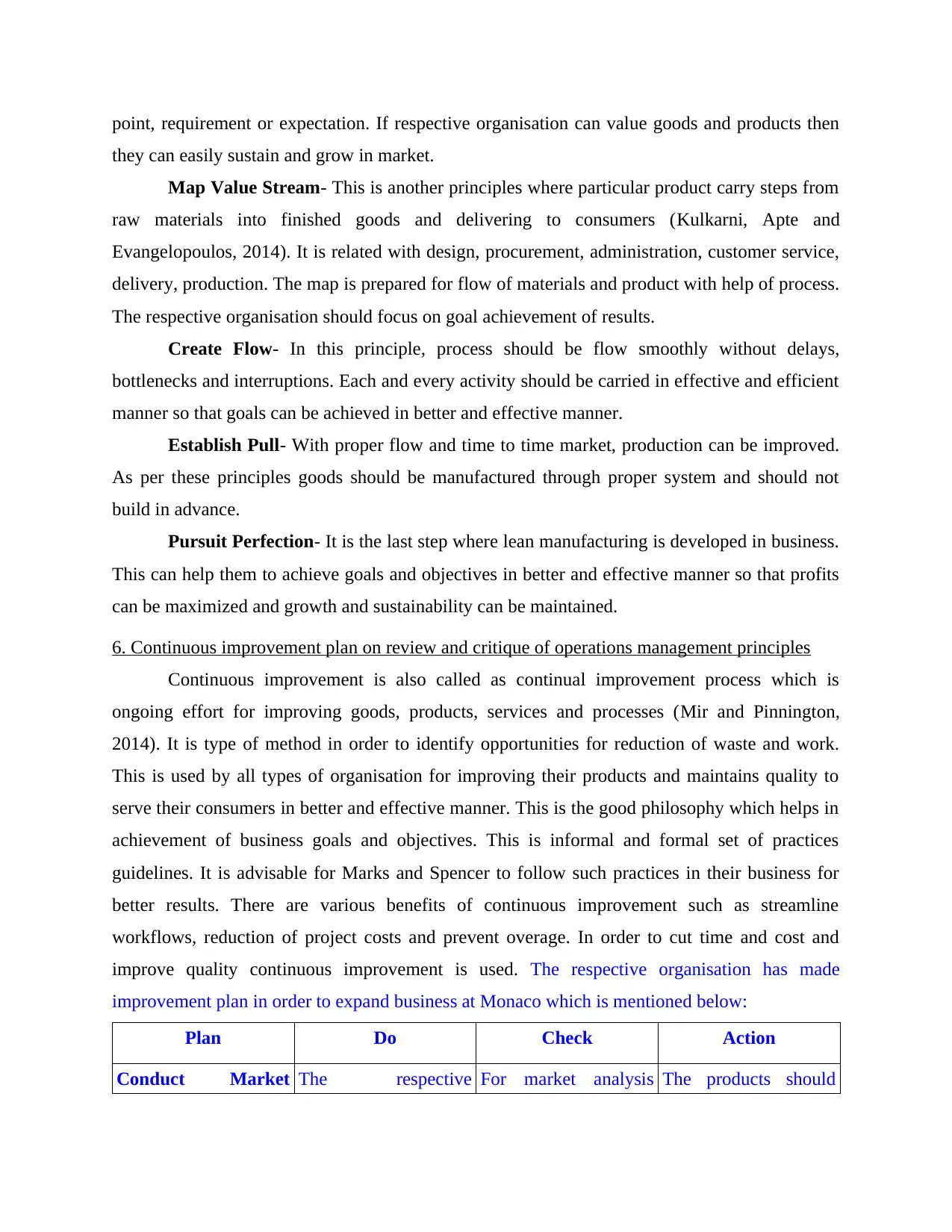
point, requirement or expectation. If respective organisation can value goods and products then
they can easily sustain and grow in market.
Map Value Stream- This is another principles where particular product carry steps from
raw materials into finished goods and delivering to consumers (Kulkarni, Apte and
Evangelopoulos, 2014). It is related with design, procurement, administration, customer service,
delivery, production. The map is prepared for flow of materials and product with help of process.
The respective organisation should focus on goal achievement of results.
Create Flow- In this principle, process should be flow smoothly without delays,
bottlenecks and interruptions. Each and every activity should be carried in effective and efficient
manner so that goals can be achieved in better and effective manner.
Establish Pull- With proper flow and time to time market, production can be improved.
As per these principles goods should be manufactured through proper system and should not
build in advance.
Pursuit Perfection- It is the last step where lean manufacturing is developed in business.
This can help them to achieve goals and objectives in better and effective manner so that profits
can be maximized and growth and sustainability can be maintained.
6. Continuous improvement plan on review and critique of operations management principles
Continuous improvement is also called as continual improvement process which is
ongoing effort for improving goods, products, services and processes (Mir and Pinnington,
2014). It is type of method in order to identify opportunities for reduction of waste and work.
This is used by all types of organisation for improving their products and maintains quality to
serve their consumers in better and effective manner. This is the good philosophy which helps in
achievement of business goals and objectives. This is informal and formal set of practices
guidelines. It is advisable for Marks and Spencer to follow such practices in their business for
better results. There are various benefits of continuous improvement such as streamline
workflows, reduction of project costs and prevent overage. In order to cut time and cost and
improve quality continuous improvement is used. The respective organisation has made
improvement plan in order to expand business at Monaco which is mentioned below:
Plan Do Check Action
Conduct Market The respective For market analysis The products should
they can easily sustain and grow in market.
Map Value Stream- This is another principles where particular product carry steps from
raw materials into finished goods and delivering to consumers (Kulkarni, Apte and
Evangelopoulos, 2014). It is related with design, procurement, administration, customer service,
delivery, production. The map is prepared for flow of materials and product with help of process.
The respective organisation should focus on goal achievement of results.
Create Flow- In this principle, process should be flow smoothly without delays,
bottlenecks and interruptions. Each and every activity should be carried in effective and efficient
manner so that goals can be achieved in better and effective manner.
Establish Pull- With proper flow and time to time market, production can be improved.
As per these principles goods should be manufactured through proper system and should not
build in advance.
Pursuit Perfection- It is the last step where lean manufacturing is developed in business.
This can help them to achieve goals and objectives in better and effective manner so that profits
can be maximized and growth and sustainability can be maintained.
6. Continuous improvement plan on review and critique of operations management principles
Continuous improvement is also called as continual improvement process which is
ongoing effort for improving goods, products, services and processes (Mir and Pinnington,
2014). It is type of method in order to identify opportunities for reduction of waste and work.
This is used by all types of organisation for improving their products and maintains quality to
serve their consumers in better and effective manner. This is the good philosophy which helps in
achievement of business goals and objectives. This is informal and formal set of practices
guidelines. It is advisable for Marks and Spencer to follow such practices in their business for
better results. There are various benefits of continuous improvement such as streamline
workflows, reduction of project costs and prevent overage. In order to cut time and cost and
improve quality continuous improvement is used. The respective organisation has made
improvement plan in order to expand business at Monaco which is mentioned below:
Plan Do Check Action
Conduct Market The respective For market analysis The products should
Paraphrase This Document
Need a fresh take? Get an instant paraphrase of this document with our AI Paraphraser
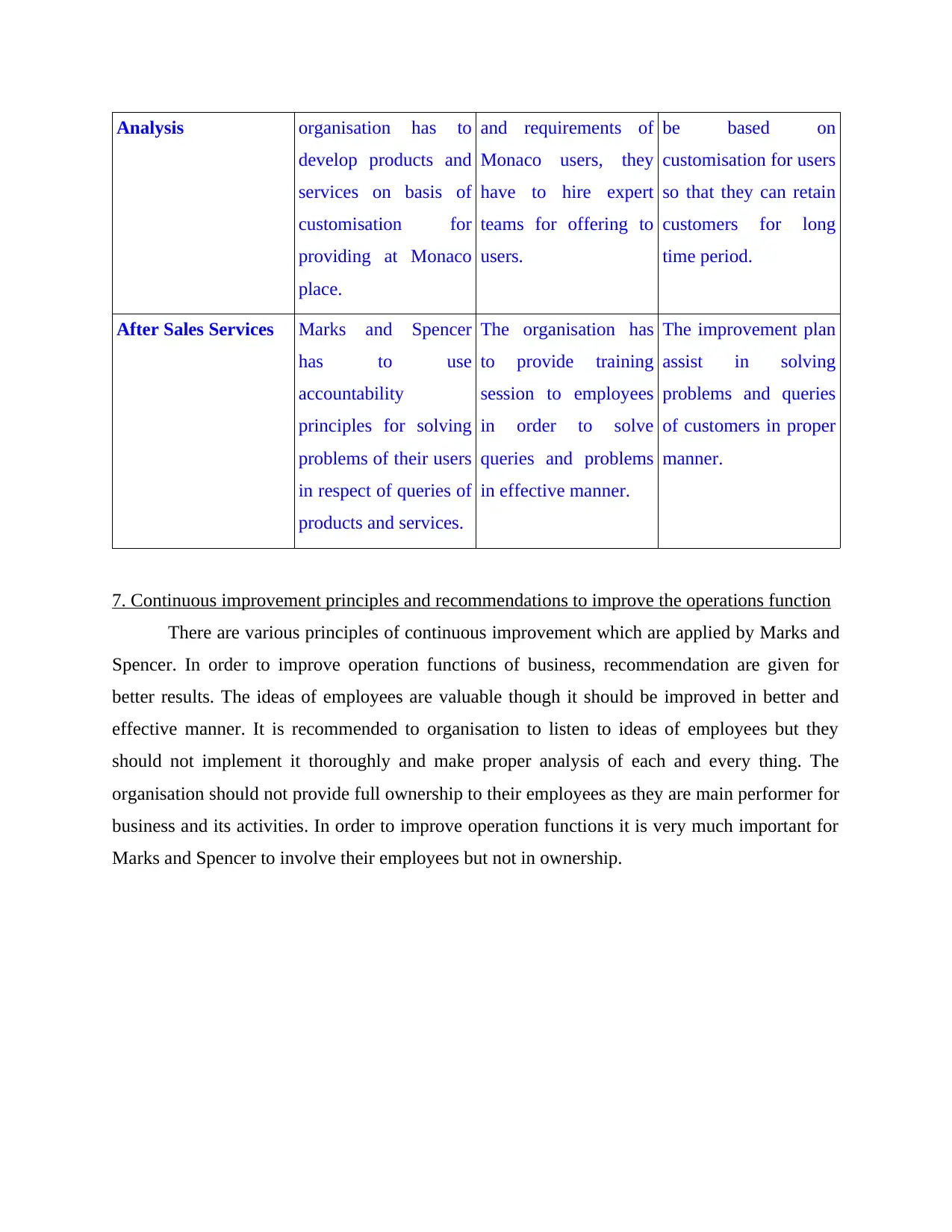
Analysis organisation has to
develop products and
services on basis of
customisation for
providing at Monaco
place.
and requirements of
Monaco users, they
have to hire expert
teams for offering to
users.
be based on
customisation for users
so that they can retain
customers for long
time period.
After Sales Services Marks and Spencer
has to use
accountability
principles for solving
problems of their users
in respect of queries of
products and services.
The organisation has
to provide training
session to employees
in order to solve
queries and problems
in effective manner.
The improvement plan
assist in solving
problems and queries
of customers in proper
manner.
7. Continuous improvement principles and recommendations to improve the operations function
There are various principles of continuous improvement which are applied by Marks and
Spencer. In order to improve operation functions of business, recommendation are given for
better results. The ideas of employees are valuable though it should be improved in better and
effective manner. It is recommended to organisation to listen to ideas of employees but they
should not implement it thoroughly and make proper analysis of each and every thing. The
organisation should not provide full ownership to their employees as they are main performer for
business and its activities. In order to improve operation functions it is very much important for
Marks and Spencer to involve their employees but not in ownership.
develop products and
services on basis of
customisation for
providing at Monaco
place.
and requirements of
Monaco users, they
have to hire expert
teams for offering to
users.
be based on
customisation for users
so that they can retain
customers for long
time period.
After Sales Services Marks and Spencer
has to use
accountability
principles for solving
problems of their users
in respect of queries of
products and services.
The organisation has
to provide training
session to employees
in order to solve
queries and problems
in effective manner.
The improvement plan
assist in solving
problems and queries
of customers in proper
manner.
7. Continuous improvement principles and recommendations to improve the operations function
There are various principles of continuous improvement which are applied by Marks and
Spencer. In order to improve operation functions of business, recommendation are given for
better results. The ideas of employees are valuable though it should be improved in better and
effective manner. It is recommended to organisation to listen to ideas of employees but they
should not implement it thoroughly and make proper analysis of each and every thing. The
organisation should not provide full ownership to their employees as they are main performer for
business and its activities. In order to improve operation functions it is very much important for
Marks and Spencer to involve their employees but not in ownership.
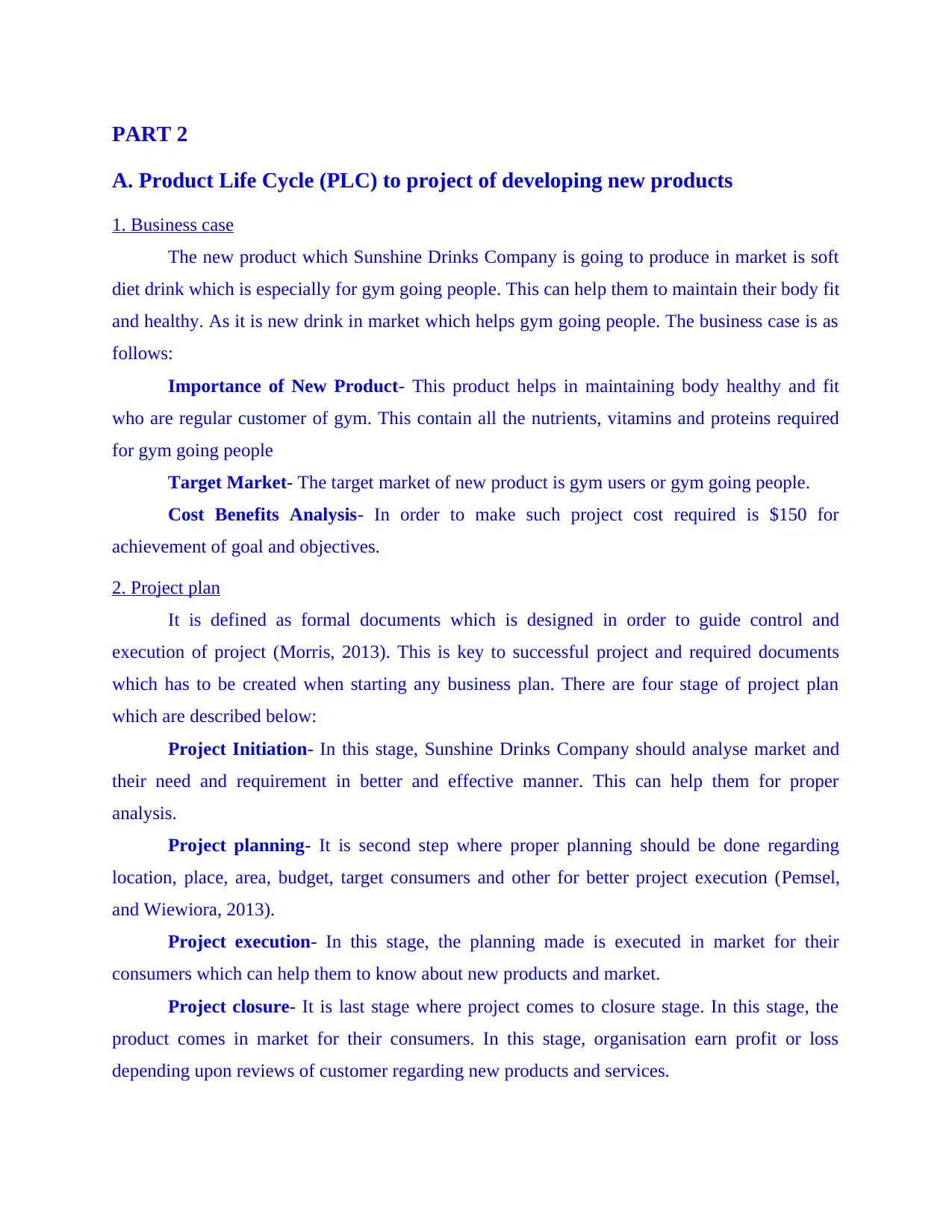
PART 2
A. Product Life Cycle (PLC) to project of developing new products
1. Business case
The new product which Sunshine Drinks Company is going to produce in market is soft
diet drink which is especially for gym going people. This can help them to maintain their body fit
and healthy. As it is new drink in market which helps gym going people. The business case is as
follows:
Importance of New Product- This product helps in maintaining body healthy and fit
who are regular customer of gym. This contain all the nutrients, vitamins and proteins required
for gym going people
Target Market- The target market of new product is gym users or gym going people.
Cost Benefits Analysis- In order to make such project cost required is $150 for
achievement of goal and objectives.
2. Project plan
It is defined as formal documents which is designed in order to guide control and
execution of project (Morris, 2013). This is key to successful project and required documents
which has to be created when starting any business plan. There are four stage of project plan
which are described below:
Project Initiation- In this stage, Sunshine Drinks Company should analyse market and
their need and requirement in better and effective manner. This can help them for proper
analysis.
Project planning- It is second step where proper planning should be done regarding
location, place, area, budget, target consumers and other for better project execution (Pemsel,
and Wiewiora, 2013).
Project execution- In this stage, the planning made is executed in market for their
consumers which can help them to know about new products and market.
Project closure- It is last stage where project comes to closure stage. In this stage, the
product comes in market for their consumers. In this stage, organisation earn profit or loss
depending upon reviews of customer regarding new products and services.
A. Product Life Cycle (PLC) to project of developing new products
1. Business case
The new product which Sunshine Drinks Company is going to produce in market is soft
diet drink which is especially for gym going people. This can help them to maintain their body fit
and healthy. As it is new drink in market which helps gym going people. The business case is as
follows:
Importance of New Product- This product helps in maintaining body healthy and fit
who are regular customer of gym. This contain all the nutrients, vitamins and proteins required
for gym going people
Target Market- The target market of new product is gym users or gym going people.
Cost Benefits Analysis- In order to make such project cost required is $150 for
achievement of goal and objectives.
2. Project plan
It is defined as formal documents which is designed in order to guide control and
execution of project (Morris, 2013). This is key to successful project and required documents
which has to be created when starting any business plan. There are four stage of project plan
which are described below:
Project Initiation- In this stage, Sunshine Drinks Company should analyse market and
their need and requirement in better and effective manner. This can help them for proper
analysis.
Project planning- It is second step where proper planning should be done regarding
location, place, area, budget, target consumers and other for better project execution (Pemsel,
and Wiewiora, 2013).
Project execution- In this stage, the planning made is executed in market for their
consumers which can help them to know about new products and market.
Project closure- It is last stage where project comes to closure stage. In this stage, the
product comes in market for their consumers. In this stage, organisation earn profit or loss
depending upon reviews of customer regarding new products and services.

3. Work Breakdown Structure (WBS) for developing of a new product
It is defined as structure which helps in dividing work of project into small parts and each
task is delegated to skilled and capable person for better achievement of goals and objectives.
This assist in handling large size project work and provide more productive outcomes. It make
work more easy and simple by dividing task into smaller forms.
4. Gantt Chart based on the WBS depicting critical path and project completion time frame
It is described as graphical representation of diagram that depicts both starting and finish
date of given work, task dependencies, person liable for project (Ramasesh and Browning,
2014). This helps in defining date in order to complete assigned project work in an effective and
efficient manner.
It is defined as structure which helps in dividing work of project into small parts and each
task is delegated to skilled and capable person for better achievement of goals and objectives.
This assist in handling large size project work and provide more productive outcomes. It make
work more easy and simple by dividing task into smaller forms.
4. Gantt Chart based on the WBS depicting critical path and project completion time frame
It is described as graphical representation of diagram that depicts both starting and finish
date of given work, task dependencies, person liable for project (Ramasesh and Browning,
2014). This helps in defining date in order to complete assigned project work in an effective and
efficient manner.
Secure Best Marks with AI Grader
Need help grading? Try our AI Grader for instant feedback on your assignments.
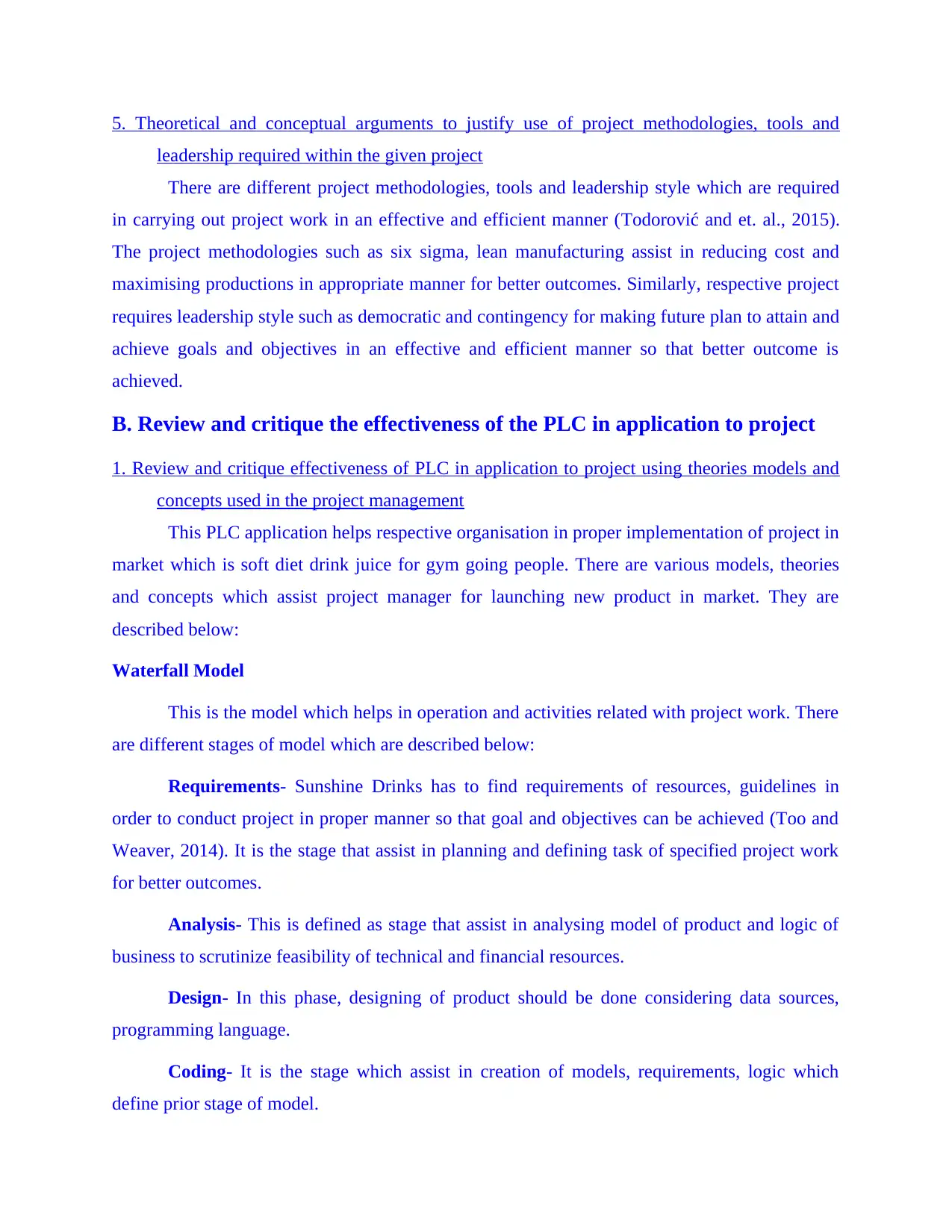
5. Theoretical and conceptual arguments to justify use of project methodologies, tools and
leadership required within the given project
There are different project methodologies, tools and leadership style which are required
in carrying out project work in an effective and efficient manner (Todorović and et. al., 2015).
The project methodologies such as six sigma, lean manufacturing assist in reducing cost and
maximising productions in appropriate manner for better outcomes. Similarly, respective project
requires leadership style such as democratic and contingency for making future plan to attain and
achieve goals and objectives in an effective and efficient manner so that better outcome is
achieved.
B. Review and critique the effectiveness of the PLC in application to project
1. Review and critique effectiveness of PLC in application to project using theories models and
concepts used in the project management
This PLC application helps respective organisation in proper implementation of project in
market which is soft diet drink juice for gym going people. There are various models, theories
and concepts which assist project manager for launching new product in market. They are
described below:
Waterfall Model
This is the model which helps in operation and activities related with project work. There
are different stages of model which are described below:
Requirements- Sunshine Drinks has to find requirements of resources, guidelines in
order to conduct project in proper manner so that goal and objectives can be achieved (Too and
Weaver, 2014). It is the stage that assist in planning and defining task of specified project work
for better outcomes.
Analysis- This is defined as stage that assist in analysing model of product and logic of
business to scrutinize feasibility of technical and financial resources.
Design- In this phase, designing of product should be done considering data sources,
programming language.
Coding- It is the stage which assist in creation of models, requirements, logic which
define prior stage of model.
leadership required within the given project
There are different project methodologies, tools and leadership style which are required
in carrying out project work in an effective and efficient manner (Todorović and et. al., 2015).
The project methodologies such as six sigma, lean manufacturing assist in reducing cost and
maximising productions in appropriate manner for better outcomes. Similarly, respective project
requires leadership style such as democratic and contingency for making future plan to attain and
achieve goals and objectives in an effective and efficient manner so that better outcome is
achieved.
B. Review and critique the effectiveness of the PLC in application to project
1. Review and critique effectiveness of PLC in application to project using theories models and
concepts used in the project management
This PLC application helps respective organisation in proper implementation of project in
market which is soft diet drink juice for gym going people. There are various models, theories
and concepts which assist project manager for launching new product in market. They are
described below:
Waterfall Model
This is the model which helps in operation and activities related with project work. There
are different stages of model which are described below:
Requirements- Sunshine Drinks has to find requirements of resources, guidelines in
order to conduct project in proper manner so that goal and objectives can be achieved (Too and
Weaver, 2014). It is the stage that assist in planning and defining task of specified project work
for better outcomes.
Analysis- This is defined as stage that assist in analysing model of product and logic of
business to scrutinize feasibility of technical and financial resources.
Design- In this phase, designing of product should be done considering data sources,
programming language.
Coding- It is the stage which assist in creation of models, requirements, logic which
define prior stage of model.
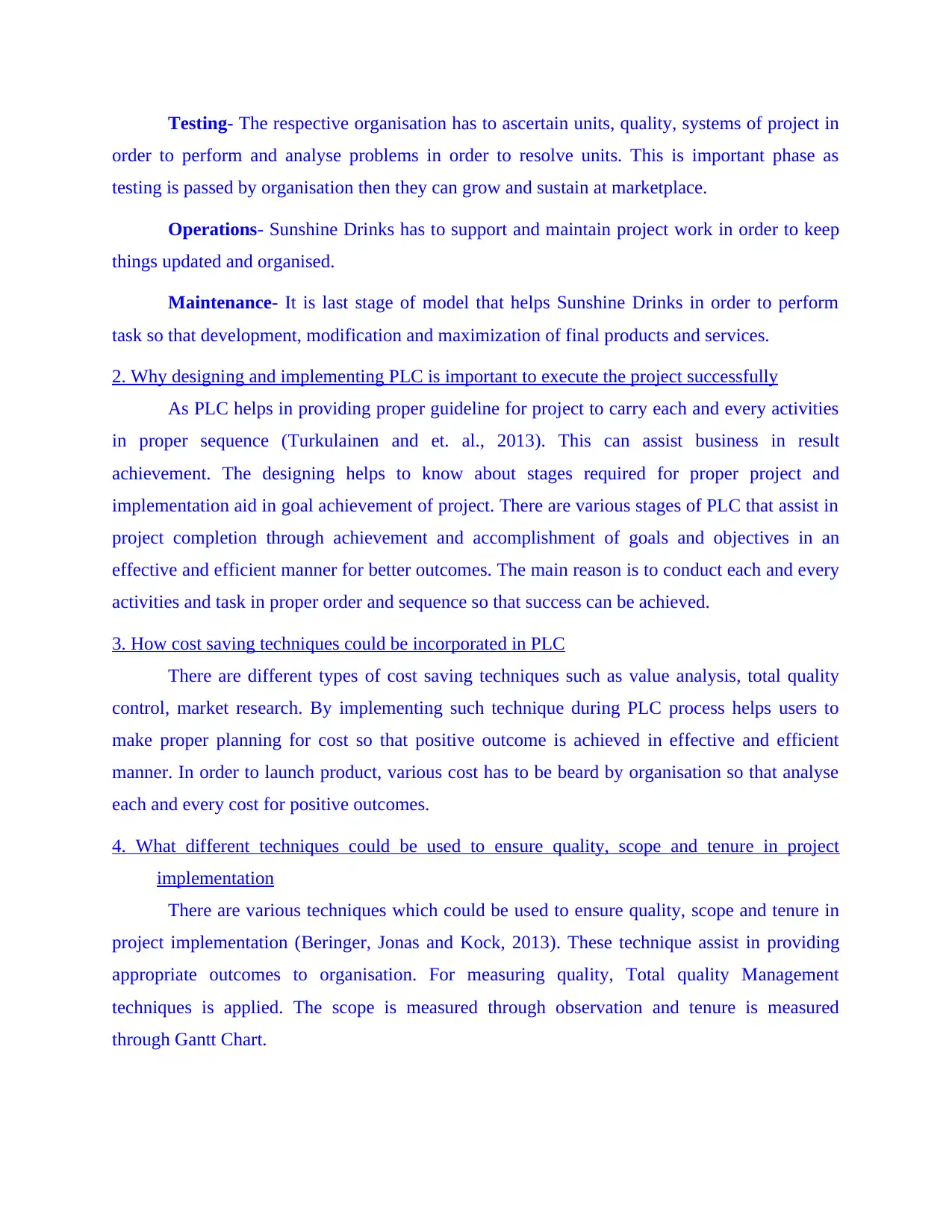
Testing- The respective organisation has to ascertain units, quality, systems of project in
order to perform and analyse problems in order to resolve units. This is important phase as
testing is passed by organisation then they can grow and sustain at marketplace.
Operations- Sunshine Drinks has to support and maintain project work in order to keep
things updated and organised.
Maintenance- It is last stage of model that helps Sunshine Drinks in order to perform
task so that development, modification and maximization of final products and services.
2. Why designing and implementing PLC is important to execute the project successfully
As PLC helps in providing proper guideline for project to carry each and every activities
in proper sequence (Turkulainen and et. al., 2013). This can assist business in result
achievement. The designing helps to know about stages required for proper project and
implementation aid in goal achievement of project. There are various stages of PLC that assist in
project completion through achievement and accomplishment of goals and objectives in an
effective and efficient manner for better outcomes. The main reason is to conduct each and every
activities and task in proper order and sequence so that success can be achieved.
3. How cost saving techniques could be incorporated in PLC
There are different types of cost saving techniques such as value analysis, total quality
control, market research. By implementing such technique during PLC process helps users to
make proper planning for cost so that positive outcome is achieved in effective and efficient
manner. In order to launch product, various cost has to be beard by organisation so that analyse
each and every cost for positive outcomes.
4. What different techniques could be used to ensure quality, scope and tenure in project
implementation
There are various techniques which could be used to ensure quality, scope and tenure in
project implementation (Beringer, Jonas and Kock, 2013). These technique assist in providing
appropriate outcomes to organisation. For measuring quality, Total quality Management
techniques is applied. The scope is measured through observation and tenure is measured
through Gantt Chart.
order to perform and analyse problems in order to resolve units. This is important phase as
testing is passed by organisation then they can grow and sustain at marketplace.
Operations- Sunshine Drinks has to support and maintain project work in order to keep
things updated and organised.
Maintenance- It is last stage of model that helps Sunshine Drinks in order to perform
task so that development, modification and maximization of final products and services.
2. Why designing and implementing PLC is important to execute the project successfully
As PLC helps in providing proper guideline for project to carry each and every activities
in proper sequence (Turkulainen and et. al., 2013). This can assist business in result
achievement. The designing helps to know about stages required for proper project and
implementation aid in goal achievement of project. There are various stages of PLC that assist in
project completion through achievement and accomplishment of goals and objectives in an
effective and efficient manner for better outcomes. The main reason is to conduct each and every
activities and task in proper order and sequence so that success can be achieved.
3. How cost saving techniques could be incorporated in PLC
There are different types of cost saving techniques such as value analysis, total quality
control, market research. By implementing such technique during PLC process helps users to
make proper planning for cost so that positive outcome is achieved in effective and efficient
manner. In order to launch product, various cost has to be beard by organisation so that analyse
each and every cost for positive outcomes.
4. What different techniques could be used to ensure quality, scope and tenure in project
implementation
There are various techniques which could be used to ensure quality, scope and tenure in
project implementation (Beringer, Jonas and Kock, 2013). These technique assist in providing
appropriate outcomes to organisation. For measuring quality, Total quality Management
techniques is applied. The scope is measured through observation and tenure is measured
through Gantt Chart.
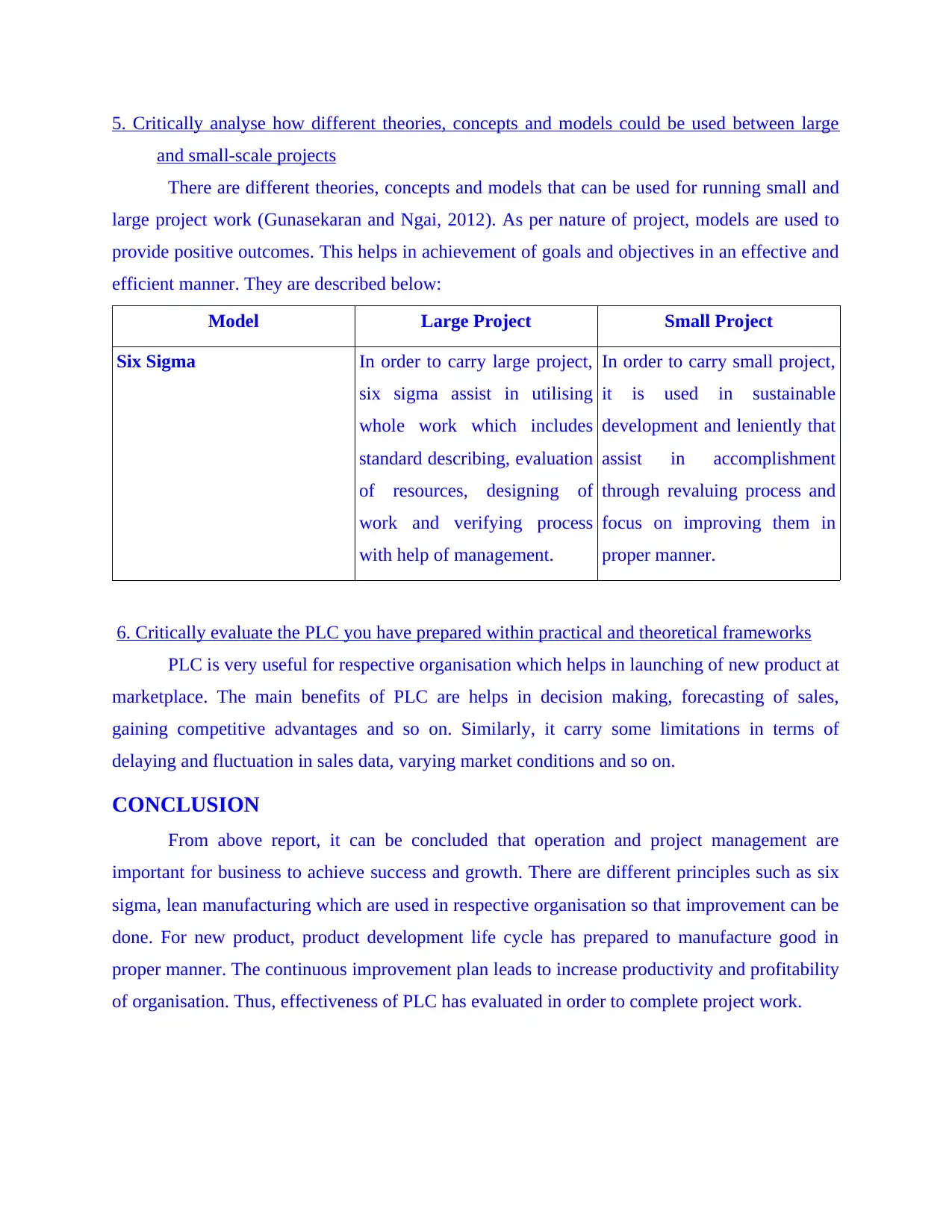
5. Critically analyse how different theories, concepts and models could be used between large
and small-scale projects
There are different theories, concepts and models that can be used for running small and
large project work (Gunasekaran and Ngai, 2012). As per nature of project, models are used to
provide positive outcomes. This helps in achievement of goals and objectives in an effective and
efficient manner. They are described below:
Model Large Project Small Project
Six Sigma In order to carry large project,
six sigma assist in utilising
whole work which includes
standard describing, evaluation
of resources, designing of
work and verifying process
with help of management.
In order to carry small project,
it is used in sustainable
development and leniently that
assist in accomplishment
through revaluing process and
focus on improving them in
proper manner.
6. Critically evaluate the PLC you have prepared within practical and theoretical frameworks
PLC is very useful for respective organisation which helps in launching of new product at
marketplace. The main benefits of PLC are helps in decision making, forecasting of sales,
gaining competitive advantages and so on. Similarly, it carry some limitations in terms of
delaying and fluctuation in sales data, varying market conditions and so on.
CONCLUSION
From above report, it can be concluded that operation and project management are
important for business to achieve success and growth. There are different principles such as six
sigma, lean manufacturing which are used in respective organisation so that improvement can be
done. For new product, product development life cycle has prepared to manufacture good in
proper manner. The continuous improvement plan leads to increase productivity and profitability
of organisation. Thus, effectiveness of PLC has evaluated in order to complete project work.
and small-scale projects
There are different theories, concepts and models that can be used for running small and
large project work (Gunasekaran and Ngai, 2012). As per nature of project, models are used to
provide positive outcomes. This helps in achievement of goals and objectives in an effective and
efficient manner. They are described below:
Model Large Project Small Project
Six Sigma In order to carry large project,
six sigma assist in utilising
whole work which includes
standard describing, evaluation
of resources, designing of
work and verifying process
with help of management.
In order to carry small project,
it is used in sustainable
development and leniently that
assist in accomplishment
through revaluing process and
focus on improving them in
proper manner.
6. Critically evaluate the PLC you have prepared within practical and theoretical frameworks
PLC is very useful for respective organisation which helps in launching of new product at
marketplace. The main benefits of PLC are helps in decision making, forecasting of sales,
gaining competitive advantages and so on. Similarly, it carry some limitations in terms of
delaying and fluctuation in sales data, varying market conditions and so on.
CONCLUSION
From above report, it can be concluded that operation and project management are
important for business to achieve success and growth. There are different principles such as six
sigma, lean manufacturing which are used in respective organisation so that improvement can be
done. For new product, product development life cycle has prepared to manufacture good in
proper manner. The continuous improvement plan leads to increase productivity and profitability
of organisation. Thus, effectiveness of PLC has evaluated in order to complete project work.
Paraphrase This Document
Need a fresh take? Get an instant paraphrase of this document with our AI Paraphraser

REFERENCES
Books and Journals
Beringer, C., Jonas, D. and Kock, A., 2013. Behavior of internal stakeholders in project portfolio
management and its impact on success. International Journal of Project Management.
31(6). pp.830-846.
Gunasekaran, A. and Ngai, E. W., 2012. The future of operations management: an outlook and
analysis. International Journal of Production Economics. 135(2). pp.687-701.
Harrison, F. and Lock, D., 2017. Advanced project management: a structured approach.
Routledge.
Jerbrant, A., 2013. Organising project-based companies: Management, control and execution of
project-based industrial operations. International Journal of Managing Projects in
Business. 6(2). pp.365-378.
Kerzner, H. and Kerzner, H. R., 2017. Project management: a systems approach to planning,
scheduling, and controlling. John Wiley & Sons.
Krajewski, L .J., Ritzman, L. P. and Malhotra, M. K., 2013. Operations management. Pearson,.
Kulkarni, S. S., Apte, U. M. and Evangelopoulos, N. E., 2014. The use of latent semantic
analysis in operations management research. Decision Sciences. 45(5). pp.971-994.
Mir, F. A. and Pinnington, A. H., 2014. Exploring the value of project management: linking
project management performance and project success. International journal of project
management. 32(2). pp.202-217.
Morris, P., 2013. Reconstructing project management reprised: A knowledge perspective.
Project Management Journal. 44(5). pp.6-23.
Pemsel, S. and Wiewiora, A., 2013. Project management office a knowledge broker in project-
based organisations. International Journal of Project Management. 31(1). pp.31-42.
Ramasesh, R. V. and Browning, T. R., 2014. A conceptual framework for tackling knowable
unknown unknowns in project management. Journal of Operations Management. 32(4).
pp.190-204.
Todorović, M. L. and et. al., 2015. Project success analysis framework: A knowledge-based
approach in project management. International Journal of Project Management. 33(4).
pp.772-783.
Too, E. G. and Weaver, P., 2014. The management of project management: A conceptual
framework for project governance. International Journal of Project Management. 32(8).
pp.1382-1394.
Turkulainen, V. and et. al., 2013. Organizing in the context of global project-based firm—The
case of sales–operations interface. Industrial Marketing Management. 42(2). pp.223-
233.
Online
What is project life cycle. 2019. [Online]. Available
Through:<https://www.mavenlink.com/resources/what-is-the-professional-
services- project-life-cycle>
Books and Journals
Beringer, C., Jonas, D. and Kock, A., 2013. Behavior of internal stakeholders in project portfolio
management and its impact on success. International Journal of Project Management.
31(6). pp.830-846.
Gunasekaran, A. and Ngai, E. W., 2012. The future of operations management: an outlook and
analysis. International Journal of Production Economics. 135(2). pp.687-701.
Harrison, F. and Lock, D., 2017. Advanced project management: a structured approach.
Routledge.
Jerbrant, A., 2013. Organising project-based companies: Management, control and execution of
project-based industrial operations. International Journal of Managing Projects in
Business. 6(2). pp.365-378.
Kerzner, H. and Kerzner, H. R., 2017. Project management: a systems approach to planning,
scheduling, and controlling. John Wiley & Sons.
Krajewski, L .J., Ritzman, L. P. and Malhotra, M. K., 2013. Operations management. Pearson,.
Kulkarni, S. S., Apte, U. M. and Evangelopoulos, N. E., 2014. The use of latent semantic
analysis in operations management research. Decision Sciences. 45(5). pp.971-994.
Mir, F. A. and Pinnington, A. H., 2014. Exploring the value of project management: linking
project management performance and project success. International journal of project
management. 32(2). pp.202-217.
Morris, P., 2013. Reconstructing project management reprised: A knowledge perspective.
Project Management Journal. 44(5). pp.6-23.
Pemsel, S. and Wiewiora, A., 2013. Project management office a knowledge broker in project-
based organisations. International Journal of Project Management. 31(1). pp.31-42.
Ramasesh, R. V. and Browning, T. R., 2014. A conceptual framework for tackling knowable
unknown unknowns in project management. Journal of Operations Management. 32(4).
pp.190-204.
Todorović, M. L. and et. al., 2015. Project success analysis framework: A knowledge-based
approach in project management. International Journal of Project Management. 33(4).
pp.772-783.
Too, E. G. and Weaver, P., 2014. The management of project management: A conceptual
framework for project governance. International Journal of Project Management. 32(8).
pp.1382-1394.
Turkulainen, V. and et. al., 2013. Organizing in the context of global project-based firm—The
case of sales–operations interface. Industrial Marketing Management. 42(2). pp.223-
233.
Online
What is project life cycle. 2019. [Online]. Available
Through:<https://www.mavenlink.com/resources/what-is-the-professional-
services- project-life-cycle>
1 out of 14
Related Documents
Your All-in-One AI-Powered Toolkit for Academic Success.
+13062052269
info@desklib.com
Available 24*7 on WhatsApp / Email
![[object Object]](/_next/static/media/star-bottom.7253800d.svg)
Unlock your academic potential
© 2024 | Zucol Services PVT LTD | All rights reserved.





